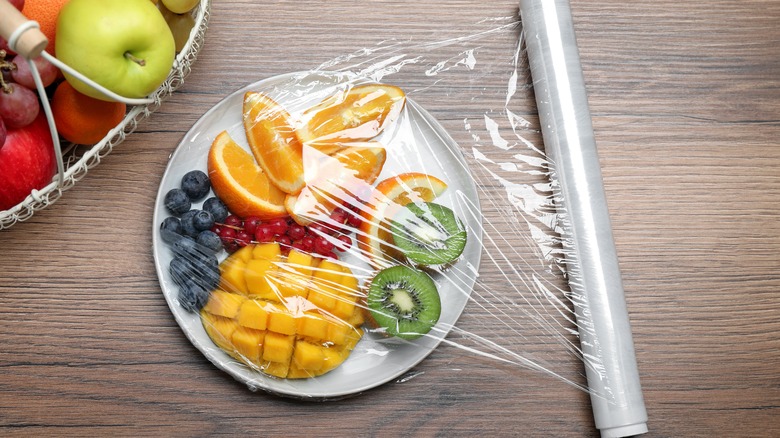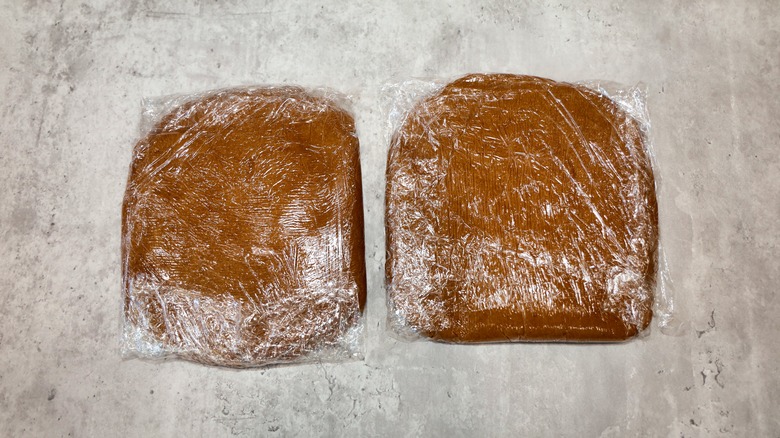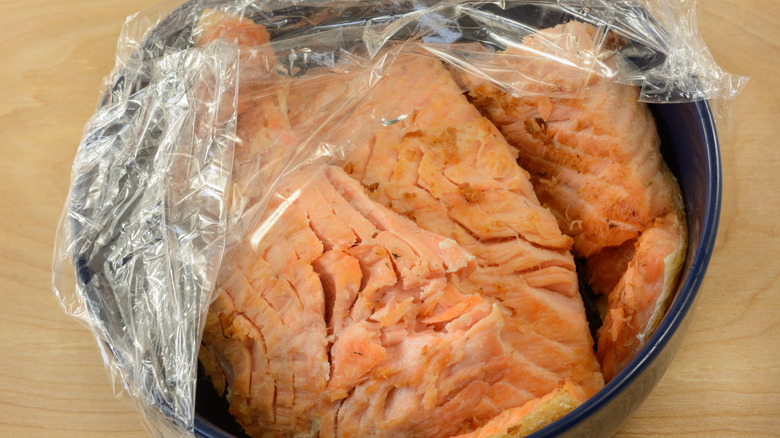The Professional Solution For Wrestling With Sticky Plastic Wrap
You have a leftover slice of pizza and you decide that you'll wrap it in some plastic wrap and put it in the fridge for later. You grab the plastic wrap out of the cabinet, rip off a sheet, and — no, wait for a second, the wrap got stuck to your hand and clumped up into a ball. You try again, tearing off a sheet, and — no, the wrap stuck to the edge of the box and ripped in half. You try and rip it off yourself, but the wrap clings to the rest of the roll.
Saran wrap, also known as plastic wrap, has been in the kitchens of many Americans since its discovery in 1933. As the story goes, at least according to DOW Chemical, a worker by the name of Ralph M. Wiley discovered "polyvinylidene chloride" by accident while at work, the resulting material being a sort of light, sticky plastic. Although the plastic material was used in everything from car seats to industrial work, its niche quickly became its use as a food wrap. While several groups, including National Geographic, have voiced their concern over plastic wrap's effects on the environment, plastic wrap's use in the kitchen has become as ubiquitous as the fork and spoon.
But it is the "sticky" property of plastic wrap that makes it so hard to use as it sticks to, well, everything. How can you get a perfect cut of plastic wrap for your leftovers without ripping and tearing the roll apart?
Chill your plastic wrap
If you are struggling with some particularly sticky cling wrap and someone comes in and tells you to "chill out," chances are that you're going to whack that person upside the head with the tube you're clutching in your hand. But "chill out" isn't just an informal way of telling someone to calm down, it's also good advice on how to solve your cling wrap problem.
According to Chef Chaz Eicke of New Jersey's "The Salad House" (via Food Network), storing plastic wrap in the refrigerator helps to prevent the wrap from getting "static," or sticking together when you try to cut it. When you remove the cooled plastic, you can easily pull out a sheet without it crinkling back onto itself. But how does putting plastic wrap in the fridge change it?
As Good Housekeeping explains, the cooler air in the refrigerator actually changes the "molecular makeup" of the plastic wrap, although in a very subtle way. Since plastic wrap is polyethylene, it "stiffens" in the cold air and loses some of its flexible or elastic properties (via ChemED X). Although plastic wrap doesn't become a thin, brittle sheet of plastic, it becomes much easier to handle without the static electricity and elasticity making it hard to cover.
You can also follow a restaurant-standard wrapping trick
When you're trying to cover a casserole dish with plastic wrap, you usually find that the plastic sheet you just ripped off (assuming those metal teeth were able to even cut the plastic at all) may not even be big enough to cover the dish. How can you get a clean, even cut that will fully cover whatever you want in a protective layer of plastic?
According to Epicurious, there's actually a trick that many hotel restaurants use to quickly wrap any ingredients or dish in plastic wrap. You begin this process by pulling out a piece of plastic wrap twice the size of the dish in question, but don't cut the plastic just yet. Then, you "wrap" the dish with plastic wrap, rather than just covering it. As you wrap around the dish, similar to how you may wrap a present, the plastic sill clings to itself rather than the food or the dish, creating a tight enclosure that prevents anything from getting in or out of the dish.
While this is better than trying to fit a misshapen square of plastic over your casserole dish, it's suggested that you use this only for large dishes that you're transporting or freezing, as the thick layer of plastic wrap will need a knife to be removed and the process may not be worth doing over and over again. It's recommended, however, that you also skip this step if it involves wrapping cheese.


